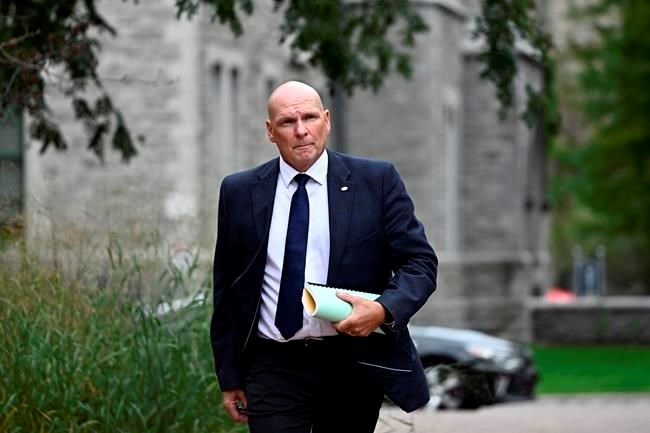OTTAWA — The emergency lane on the street along Parliament Hill was blocked by trucks that had chained themselves together during the "Freedom Convoy" protest in Ottawa last year, the city's emergency services manager told the court Wednesday.
The defence lawyer for one of the protest organizers says that statement doesn't add up with the manager's prior testimony.
Tamara Lich and Chris Barber are on trial for alleged mischief and counselling others to commit mischief, intimidation and other offences during the protest against COVID-19 public-health measures.
Kim Ayotte said the city and police had planned to keep one lane open for emergency vehicles, but it was "lost" after the first night of the protest.
Lich's lawyer Lawrence Greenspon pointed out that Ayotte gave a different answer when asked about emergency lanes last year as part of a federal inquiry into the invocation of the Emergencies Act.
"Mr. Ayotte confirmed that convoy organizers had agreed to maintain an emergency lane and did, for the most part, maintain such a lane throughout the relevant period," a summary of his interview with the inquiry's lawyers stated. Ayotte had affirmed the contents of that summary during the inquiry.
Ayotte testified Wednesday that emergency lanes were mostly maintained throughout the rest of the protest zone, and that emergency response times were still within set standards.
In addition to the parked big-rig trucks, Wellington Street lanes were clogged with protesters having a dance party, and eventually a stage was erected on the road, he said.
"Any activity that requires the use of roads for any purpose requires a permit," Ayotte said from the witness stand Wednesday.
Greenspon confirmed with Ayotte that protesters are not required to get a permit, because their right to protest is guaranteed by the Canadian Charter.
"But if you want to dance in the streets, what you've indicated in your testimony is that you have to have a permit?" Greenspon asked, and Ayotte agreed.
Ayotte had no direct contact with Lich during the protest, but he did meet with and exchange text messages with Barber.
Ayotte was the senior point person responsible for facilitating a deal between the city and protesters to move trucks out of residential neighbourhoods on Feb. 14 and Feb. 15.
"The goal was to remove vehicles from the residential areas," Ayotte said. That meant moving trucks onto Wellington Street in front of Parliament Hill or out of the city onto a farm property that was being used as a staging area for extra trucks.
A text message exchange filed as evidence in the trial shows that Ayotte checked in on the progress with Barber over those two days and offered any assistance that was needed to move barriers out of the way.
On Feb. 15, Barber texted Ayotte to say that they had helped to move 40 trucks the day before and that he was ready to get started again.
The efforts stalled shortly after that, though, when Barber said in a message to Ayotte that there had been an incident with police, and that they would need to stand down for the time being.
Ayotte said Ottawa police gave him very "limited information" about what happened.
Ayotte said he walked through the neighbourhoods at the time to confirm that some of the big trucks had moved out of the area, but he said smaller trucks had moved into their place.
"Everyone was still trying to get closer to Parliament. There wasn't a lot of movement out of the city," he said.
He told the court he went for three walks through the protest zone, and was also able to watch parts of the protest unfold from his office window.
During the first week of the protest, he said he heard the almost constant sound of honking horns from the moment he arrived in the office at 7 a.m. until when he left at 9 p.m.
After the court issued an injunction to ban horn honking downtown, the noise became more sporadic, he said.
He also described for the court the smell of diesel from idling vehicles and said he spotted open fires on the streets at times.
Greenspon took the court through some of those notes Ayotte kept during the convoy protest. They showed that police had briefed the city that there were several distinct convoy groups, and that police planned from the beginning to direct protesters' vehicles to Wellington Street.
"They were invited into the city of Ottawa, they were told how to get into the city core," Greenspon said outside the courthouse at the end of the day Wednesday.
"There's no time limit on freedom. The Charter of Rights doesn't talk about the right to peaceful assembly for up to 48 hours. ... It's a constitutionally entrenched right. The right to enjoyment of property, however, is nowhere to be found in the Canadian Constitution."
Ayotte's cross examination is expected to continue Thursday.
This report by The Canadian Press was first published Sept. 20, 2023.
Laura Osman, The Canadian Press



